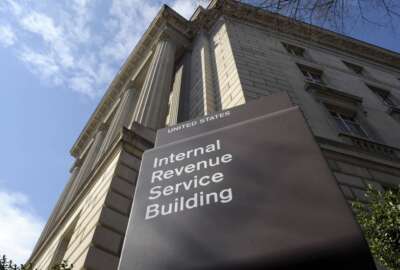Federal remote work posture should not be one-size-fits-all, OPM says
In new guidance, OPM said a thoughtful and intentional approach to federal remote work programs can significantly benefit employees who fit the bill.
Hybrid work arrangements are already in place at many federal agencies, but agency leaders are still looking to continuously evaluate their workplace posture and make adjustments as needed.
To help them make those ongoing decisions, agencies have more advice from the Office of Personnel Management, which published new federal remote work guidance Wednesday.
Fully remote work is relatively uncommon for the federal workforce. Less than 6% of federal employees were working remotely during fiscal year 2022, according to the most recent publicly available data. OPM said it views federal remote work as an opportunity to broaden workforce recruitment and retention, but agencies should still carefully evaluate their use of the flexibility.
“When thoughtfully and intentionally implemented, remote work can be a significant benefit to employers for certain types of roles in certain circumstances,” OPM Acting Director Rob Shriver wrote in Wednesday’s guidance. “At the same time, remote work is not suitable for all types of roles. Striking the right balance of in-person work and use of workplace flexibilities such as remote work is critical to support the long-term organizational health of federal agencies.”
In the federal government’s case, remote work is distinct from telework. Federal employees with remote work agreements perform their job duties at a location away from their normal work site without the expectation of regularly returning to that site. In contrast, federal employees with telework agreements, by OPM’s definition, can perform their work away from the office — but are still expected to come to the worksite “on a regular and recurring basis.”
OPM’s new guidance doesn’t change the working definitions for federal remote work or telework, but rather provides additional clarifying guidance on how agencies should approach their workplace arrangements moving forward. In the document, OPM details what factors agencies should consider as they hammer out their remote work posture — both as it currently exists, as well as what it will look like in the future.
The guidance builds on the Office of Management and Budget’s April 2023 memo that called on agencies to strike a balance between in-person work and telework, as well as 2021 OPM guidance that told agencies to weave telework and remote work into their workforce culture. Following those documents, OPM said human capital leaders and other senior executives asked for additional guidance on how to ensure agencies are relatively consistent as they consider changes to their remote work arrangements.
OPM said it’s still up to each agency to determine the right balance for workplace flexibilities, such as remote work, for their employees. Agencies can decide if they want to offer remote work in the first place. They also have the authority to determine how they’d like to use the flexibility, and what positions are potentially good candidates for the alternative workplace arrangements.
“There is no one-size-fits-all approach,” Shriver wrote in the guidance. “Certain flexible work arrangements may not make sense for every agency, function or team, or be appropriate for every position or individual.”
OPM said in the guidance that agencies should create and maintain a “standard evaluation process” to determine which employees are eligible for a federal remote work arrangement. Eligibility for remote work can depend on a lot of factors, but OPM pointed to a few key considerations agencies should make.
Specifically, OPM urged agencies to conduct a “high-level review” for remote work requests that come from senior executives, early-career workers and those living within a reasonable commuting distance from their official worksite. In each of those situations, OPM said a balance of telework and in-person work is likely a better option, rather than fully remote work.
For instance, senior executives, according to OPM’s guidance, should in most cases lean in on in-person work more so than other federal employees.
“Senior executives are critical to the culture of our agencies, and employees benefit from in-person engagement with senior leaders,” Shriver said.
As agencies have developed and executed their return-to-office plans, some have already set higher in-office expectations for senior leadership than they have for other agency employees. At the Social Security Administration, for example, employees in the commissioner’s office have to report in person four days per week, while those in field offices and hearing offices are expected to work on-site roughly three days per week.
When considering remote work requests, another group OPM asked agencies to pay special attention to is early-career employees. Younger workers early in their careers, OPM said, may get more value out of working in person than perhaps other federal employees.
In-person work “aids them in forming essential relationships, learning how the organization functions and its workplace culture, and meeting other business objectives,” Shriver wrote.
Remote work arrangements can also raise questions about the costs of pay, travel and other workforce policies, OPM said. With that in mind, the guidance emphasizes the importance of considering the individual circumstances of employees when determining possible remote work arrangements.
“Because of these policy and potential cost implications, agencies should make remote work determinations to strategically support mission and business benefits to the agency or organization,” Shriver wrote.
Regardless of the decisions an agency makes for each remote work request it receives, OPM said a senior leader should be responsible for overseeing and tracking an agency’s federal remote work program overall.
“Agencies need to ensure that all work arrangements, including remote work arrangements, facilitate, rather than impede, the accomplishment of work and long-term success of an agency’s mission,” Shriver wrote. “Moreover, agencies need to monitor the performance of employees on all work arrangements and evaluate whether the work arrangements are advancing or impeding employee performance.”
Copyright © 2024 Federal News Network. All rights reserved. This website is not intended for users located within the European Economic Area.
Drew Friedman is a workforce, pay and benefits reporter for Federal News Network.
Follow @dfriedmanWFED






